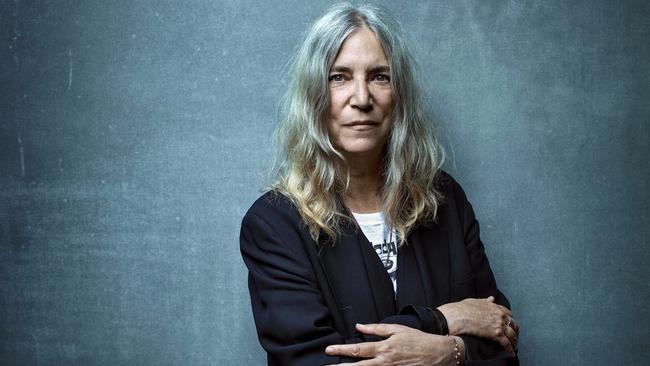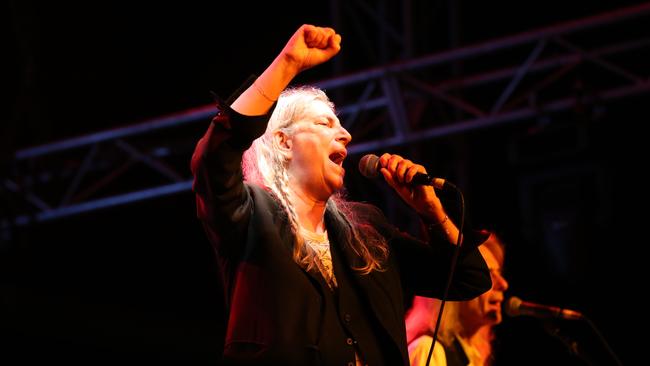Patti Smith: eyes are wide open
When American singer-songwriter Patti Smith visited Uluru in 2017 she realised a life’s dream. Now she says she wants to go back.

With her silver hair framing a blue blazer, Patti Smith took a deep breath and began to perform a song she had loved since she was a teenager. It was a Saturday evening in Stockholm in December 2016, and the US singer, songwriter, author and poet was in a highly unusual position — one that no other person on the planet had ever been in before.
Bob Dylan had been named as the first songwriter to be awarded the Nobel prize for Literature and, in his absence, Smith had been asked to perform one of his songs. She selected a sprawling, absorbing work, 1963’s A Hard Rain’s A-Gonna Fall, and her first rehearsal — accompanied largely by an acoustic guitarist and a pedal steel player, before a swelling orchestra brought the song home in its final minutes — went perfectly.
A few hours later, though, Smith was barely 90 seconds into the song before she stumbled on a lyric, then stopped. “I’m sorry, could we start that section?” she said to the conductor, then turned to the hundreds-strong audience sat before her. “I apologise. Sorry — I’m so nervous.”
At this, the crowd burst into applause. After a few beats, the guitarist began strumming again, and the singer took up where she left off. Her acute embarrassment was radiant, but no more so than her obvious desire to honour the words of the singular artist with whom she toured Australia in 1998.

Smith’s performance on that night contains multitudes. It’s an eight-minute capsule of humanity, soaked in pathos and wonder. It sees one of popular music’s greatest figures being honoured by another great who momentarily falters when faced by the significance of the occasion, only to redeem herself mightily. By the end of Dylan’s epic, she is marching on the spot, gesticulating with strength and simply owning the room.
Thinking back to that evening in Stockholm, Smith tells Review: “It was a terrible moment. I never get stage fright; I’m very at ease on stage. I don’t know why I was so overwhelmed with emotion that I could hardly speak.
“It was unique in my life, and I just think that, when I looked down at all these people — there’s the king and the queen, all the Nobel laureates, the audience, the TV cameras, the whole orchestra — I could feel everyone there for me.”
“I never for a moment felt isolated, alone — I was just heartbroken that I couldn’t do better,” she says. “And really, I think, everyone saw themselves in me at that moment. Everyone experiences a moment where they’re mortified, or they feel like the whole world’s collapsing — but then we got through it, and people erupted. They were happy because, in me getting through it, we all got through it. Does that make any sense?”
Of course it does, and here’s a theory: if history had gone another way, and if Smith had performed Dylan’s song as perfectly as she had in rehearsal, it would have been beautiful and memorable in its own right. But because she made a mistake, the wall between artist and audience dissolved into a mirror, and it elevated the performance on to another plane entirely. What do you make of that theory, Patti?
“Well, I would have to say, thank you very much,” she replies. “I have to agree with you, because the next day, when I went down into the breakfast room filled with Nobel laureates for science and medicine and physics and all kinds of things — every one of these great thinkers came up to me and thanked me.
“I said, ‘I wish I could have done better’, and they said, ‘No, no, we liked it exactly the way it was. We all were so nervous ourselves; nervous to go and receive our awards, nervous to give our speeches. We saw what you went through and it gave us some courage’.”
■ ■ ■ ■
That performance in Sweden occurred while Smith was in the midst of writing a book — an act that’s nothing new for the poet and songwriter, who completed her first manuscript on the penultimate day of 1991, her 45th birthday. Written while living outside Detroit with her husband and two children, Woolgathering was a slim, luminous volume that entwined her childhood self with memories from her 20s in New York City.
“I always imagined I would write a book, if only a small one, that would carry one away, into a realm that could not be measured nor even remembered,” she wrote on its first page. “I imagined a lot of things. That I would shine. That I’d be good. I’d dwell bareheaded on a summit turning a wheel that would turn the Earth and undetected, among the clouds, I would have some influence; be of some avail.”
She did, and she has. Her influence as a writer and performer spans art forms and generations, and continues today, into her seventh decade. She even shone in her own special way on that night in Stockholm, which she wrote about in an article for The New Yorker soon after it occurred.
“As I took my seat, I felt the humiliating sting of failure, but also the strange realisation that I had somehow entered and truly lived the world of the lyrics,” she wrote, noting that the song begins with the words “I stumbled alongside of 12 misty mountains”, and ends with the line, “And I’ll know my song well before I start singing”.
Yet the Nobel interlude is absent from Year of the Monkey, a book whose dreamlike narrative begins on New Year’s Day in 2016 and ends in January 2017, when the Chinese New Year ticks over into the Year of the Rooster. It seems a curious omission, given the history-making nature of the occasion. Why?
“That particular persona — how could I write about it? I would have to lift myself out of the atmosphere,” Smith replies. “Year of the Monkey is more than ‘what happened’; it’s an atmosphere that was created. Right in the middle of that book, I went to Japan for a month, but I didn’t write about that, either. I did, and then I eliminated that, because it broke the atmosphere of the book.
“The persona of myself in Year of the Monkey is my regular self,” she says.
“There’s a certain amount of fame or celebrity attached to doing something of that scale (in Stockholm). When I’m by myself, I’m just as I depicted: I have my old jacket, my old coat, my watch cap. When I travel in America, nobody knows anything about me. I would say most of that time (in 2016), nobody knew who I was. I don’t have a celebrity identity everywhere I go.”
In the book’s opening pages, Smith is unable to find an open cafe in the Californian coastal city of Santa Cruz to buy her first coffee of the year.
“I sat on the outside bench going over the edges of the night before,” she writes. “It was the last of three nights in a row performing at the Fillmore and I was pulling the strings off my Stratocaster when some guy with a greasy ponytail leaned over and puked on my boots. The last gasp of 2015, a spray of vomit ushering in the New Year. A good or bad sign? Well, considering the state of the world, who could tell the difference?”
This book follows a pair of compelling works in 2010’s Just Kids — which won a National Book Award in the US for nonfiction — and 2015’s M Train. Unlike its predecessors, which are both rooted in reality, Year of the Monkey blends memoir and fiction in a way that can be best described as Smithesque, so distinctive is her style. She interweaves factual storytelling of how her 2016 unfolded with dreams and conversations with inanimate objects, as well as characters who may or may not exist.
With much of that year given over to solitary wandering, Smith narrates her life of treading lightly and wondering at the world around her. She checks into unremarkable US motels with a small suitcase and few possessions, visits European cities, and travels back and forth between her home and Kentucky to visit a dying friend — all the while, carrying her notebook, pen and endless curiosity.
In its fourth chapter, she writes, “Marcus Aurelius asks us to note the passing of time with open eyes. Ten thousand years or ten thousand days, nothing can stop time, or change the fact that I would be turning seventy in the Year of the Monkey. Seventy. Merely a number but one indicating the passing of a significant percentage of the allotted sand in an egg timer, with oneself the darn egg.”
■ ■ ■ ■
Honouring the first songwriter to win a Nobel prize for Literature wasn’t the only occasion Smith turned a wheel that would alter the course of popular music, of course. Her 1975 debut, Horses, was the one that introduced her to a wide audience, where, as a formidable singer-songwriter backed by a powerhouse band, Smith became a towering figure in punk rock history.
Her third album, Easter, featured Because the Night, a stirring song co-written with Bruce Springsteen that became Smith’s biggest hit, thanks to her rousing, hopeful chorus set to his propulsive chord progression.
“I’m happy that the song has endured,” she says. “I wrote my part for my late husband, Fred ‘Sonic’ Smith, so I see that a love song that I wrote in my 20s is still popular. People say, ‘Don’t you get tired of singing it?’. But if people want to hear it, that’s what hits are for. I’ve only really had two hit songs — People Have the Power and Because the Night — and if people want to hear them, of course I’ll sing it to them.” According to a popular website that tracks live set-lists, Springsteen has performed the song in concert about 500 times, while Smith’s own tally is in excess of 1100 — a number that doesn’t include impromptu a capella versions at libraries, bookstores and in kitchens.
Wait. Kitchens? “It’s very popular in Italy,” says Smith. “And when I’m in an Italian restaurant, often they’ll say, ‘The chef said hello, and he’s so sad he can’t come out to greet you, because he has to cook. But his favourite song is Because the Night’. And so I almost always go into the kitchen and sing to the chef. I’ve sang in many kitchens in Spain and Italy; there’s probably so many little videos floating in the atmosphere, of me singing to chefs in the kitchen. It’s not my favourite song that I ever wrote, or collaborated on — but I’m so happy that it’s struck a chord in the public consciousness, and I’m always glad to sing it.”
■ ■ ■ ■
When Smith last visited Australia in April 2017, including an appearance at Bluesfest near Byron Bay, the tour was billed as her last. “With the right attitude, she pointed out, any gig could revel in the intimacy and energy of a small club gig — and that is what we enjoyed,” wrote Iain Shedden in this newspaper while reviewing a concert at Sydney’s State Theatre. “Smith wasn’t done, however,” Shedden continued. “Donning a guitar for the first time, the singer and band wreaked havoc on The Who’s My Generation, with their leader at her most ferocious. When Smith lifted her guitar up above her head, having ripped the strings from it in a glorious cacophony of feedback, and declared ‘this is where the power is’, few would have been game to argue.”
So far this year, Smith has performed more than 40 concerts throughout the United States and Europe to big crowds at theatres and festivals. As the frontwoman of a tight, accomplished band, she remains a strong draw for concertgoers of all ages. In late July, Review asked whether she’s had second thoughts about the finality of that last Australian visit.
“Well, the only reason I did that was because I don’t travel well,” she replied. “I get very bad migraines on long flights. When I went last time, I did get sick, and it took a bit of a toll on me. But it was such a welcoming tour, and I’ve thought so much about it. I loved that tour, also because at the end of it, the band went home and I went to Uluru and I accomplished a life’s dream. That means quite a bit to me. If I feel in myself that I can do that — let’s not shut the door yet.”
In mid-August, Smith and her band were announced as one of the headlining artists at Bluesfest 2020, alongside Crowded House and Dave Matthews Band. When Review calls the day after this news is made public, she answers the phone while sitting in the back of a cafe on the Spanish coast, midway through a European tour. The previous night, she had shared a video with her 462,000 followers on Instagram, where she regularly posts photos of her daily encounters, often accompanied by short poems.
“I saw fireworks last night, just by accident, in this town of San Sebastian and I posted it — and all the comments weren’t about the fireworks,” she tells Review with a laugh. “There were more comments about coming back to Australia. So I feel welcome already. The one thing I would like to say is that I don’t like to make announcements that are so finite, and then break it. It’s like breaking a promise. I really didn’t expect to be coming back, but it was just such a great trip.”
“And also, in Year of the Monkey, I kept wanting to go to see Uluru,” she says. “And I finally did (in 2017), and it was so magical, that I thought I should like to return. I really thought that I wouldn’t be able to come back — so I’m delighted that I was wrong.”
Ahead of her return to these shores in April, Smith plans to take a break from performances during the first three months of 2020. “I’ll be getting into my strongest shape possible,” she says. “I will be turning 73, but I feel completely fit. I feel ready for the task.” As well, the band leader will be bringing a guitarist who has never played here before: her son, Jackson. “He’s a great guitarist, and his father was Fred ‘Sonic’ Smith; I mean, my son is a virtuoso, with great personality,” she says.
Her unvarnished delight at the thought of soon sharing Australian stages with her band and her son is audible down the line, as she sits in a cafe in northern Spain, noting the passing of time with open eyes.
Year of the Monkey is published on Tuesday via Bloomsbury.
Patti Smith performs at Bluesfest on April 9-13 2020, with more Australian dates soon to be announced.




To join the conversation, please log in. Don't have an account? Register
Join the conversation, you are commenting as Logout